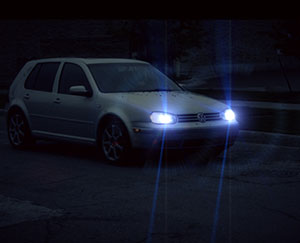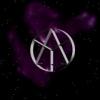It's not so much the lens flare but the initial flare effect which I believe can be witnessed without looking through a camera. If you look at a street lamp at night you will notice a distinctive flare around the light source. I'm not sure what to call this effect though.
There's two overlapping effects around a street lamp at night.
One is a lens flare -- in your original picture of the car, the radial lines, doughnut-shaped rings and the central glow are a lens flare.
This part of the effect will fade/shrink as you raise your hand and cover the street lamp / light-bulb from your view.
After covering the street-lamp with your hand / thumb, the first glow will disappear (as it's occurring in your eye/lens), but the second one will remain. This is a large halo around the light (not really present in your first picture), caused by particles in the air scattering the light. On humid/misty nights, or in polluted areas, this effect will be more pronounced as there will be more of these scattering particles.
Ideally, this would be rendered as a volumetric halo, or a regular point light affecting a volumetric fog.











